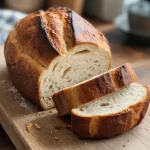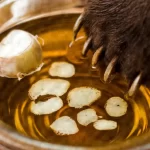There’s something incredibly satisfying about crafting this lemon tart from scratch—it combines the perfect balance of tart lemon flavor with a buttery, flaky crust that simply melts in your mouth. Plus, the process of making it is like a therapeutic culinary escape that ends with a stunning, deliciously zesty treat to share (or not!) with friends.

Creating this Classic French Lemon Tart (Tarte au Citron) is a labor of love for me. It is a dessert that perfectly balances sweet and tart flavors.
I use a standard short crust for the base: 1 ½ cups all-purpose flour, ½ cup very cold unsalted butter cut into little cubes, and a few other straightforward ingredients. The filling, also delicious, starts with ¾ cup of fresh lemon juice and the zest of two lemons.
I beat together four large eggs and ½ cup heavy cream. The filling partners beautifully with the crust, and then I finish the tart by dusting it with powdered sugar.
Ingredients

Universal flour: It offers architecture and sugars.
Butter, unsalted: Contributes richness and texture.
Sweetening granulated sugar: Provides the correct amount of sweetness to balance the tartness.
Lemon juice: Gives bright sourness and offers vitamin C.
Lemon peel: Concentrates lemon taste and smell.
Eggs: Provide protein and serve as a binding agent.
Thick cream: Includes a combination of whipping cream with a high butterfat content and gelatin.
Add to filling to make it more stable and help it hold its shape.
Ingredient Quantities
“`html
- 1 ½ cups all-purpose flour
- ½ cup unsalted butter, cold and cubed
- ¼ cup granulated sugar
- 1 large egg
- Pinch of salt
- 1 cup granulated sugar (for filling)
- ¾ cup fresh lemon juice (about 4-5 lemons)
- Zest of 2 lemons
- 4 large eggs
- ½ cup heavy cream
- Pinch of salt (for filling)
- Powdered sugar for dusting (optional)
“`
Instructions
1. Prepare the Crust
In a mixing bowl, combine 1½ cups of all-purpose flour, ¼ cup of granulated sugar, and a tiny dash of salt. Then, add ½ cup of cold, cubed unsalted butter and mix using your fingers until it resembles coarse crumbs.
2. Add the Egg
Incorporate 1 large egg into the crumbly mixture and mix until the dough begins to form. Shape it into a disk. Wrap it in plastic wrap and chill for at least 30 minutes.
3. Preheat and Roll
Heat your oven to 350°F (175°C). After the dough has cooled in the fridge, roll it out on a lightly floured surface until it is a circle that can fit in a 9-inch tart pan. Very carefully place the dough in the pan, making sure it is pressed into all the edges; trim any overhang. If there are cracks in the dough, you can pinch the dough together to repair it.
4. Blind Bake the Crust
Poke the dough all over with a fork. Place the crust in a pan and line it with parchment paper. Fill the lined crust with weights and bake for 15 minutes. Then, remove the weights and parchment and bake for 10 more minutes until the crust is lightly golden. Let the crust cool.
5. Prepare the Filling
In a medium saucepan, mix together 1 cup of granulated sugar, ¾ cup of fresh lemon juice, the zest of 2 lemons, and a pinch of salt. Over medium heat, stir until the sugar is completely dissolved.
6. Whisk in Eggs
In another bowl, take 4 large eggs and beat them lightly. While continuously whisking, add the eggs to the lemon mixture very gradually. This will help avoid curdling.
7. Thicken the Filling
Keep the mixture cooking over medium-low heat, always stirring until it has thickened and now coats the back of a spoon. Take it off the heat.
8. Add Cream and Finalize
Mix in 1/2 cup of heavy cream; make sure it is fully blended and silky smooth. Fill the tart shell with the mixture.
9. Bake the Tart
Put the tart back in the oven, and bake it for 20 to 25 minutes at 350 degrees F (175 degrees C), or until the filling is mostly set but still a bit jiggly in the center.
10. Cool and Serve
Make sure the tart is completely cool before putting it in the refrigerator. Let it chill in there for 2 hours at least (I often let it go overnight). If you want, you can dust it with powdered sugar before serving.
Equipment Needed
1. Mixing bowl
2. Measuring cups and spoons
3. Fork
4. Rolling pin
5. Plastic wrap
6. Tart pan (9-inch)
7. Parchment paper
8. Baking weights (e.g., dry beans or pie weights)
9. Medium saucepan
10. Whisk
11. Spoon
12. Zester or grater
13. Oven
14. Refrigerator
FAQ
- Q: Can I use store-bought pastry for the crust?
A: Yes, you can use store-bought pastry to save time, but homemade crust offers a more authentic flavor and texture. - Q: How do I know when the lemon filling is set?
A: The filling should be set around the edges but still slightly wobbly in the center. It will firm up as it cools. - Q: Can I prepare the lemon tart in advance?
A: Yes, the tart can be made a day ahead. Store it in the refrigerator and serve chilled or at room temperature. - Q: What can I use if I don’t have fresh lemons?
A: For the best flavor, fresh lemons are recommended. However, you can use bottled lemon juice in a pinch, adjusting for taste. - Q: Is it necessary to strain the filling?
A: Straining the filling can help remove any lumps or zest for a smoother texture, but it is not strictly necessary. - Q: How can I prevent the crust from shrinking?
A: Chill the dough thoroughly before rolling and baking, and avoid stretching it when placing it in the tart pan. - Q: Can I add other flavors to the tart?
A: Yes, you can infuse the filling with vanilla bean or add herbs like thyme for a unique twist.
Substitutions and Variations
Substitutes for all-purpose flour include: Whole wheat flour. This imparts a protein-rich, nutty taste, and it’s denser in texture.
Butter that is not salted: Substitute with coconut oil for a dairy-free alternative.
Granulated sugar: Substitute coconut sugar to have a more natural sweetener.
Lemon juice, fresh: If you can’t get your hands on the fresh fruit, it’s perfectly fine to use an equal measure of bottled lemon juice. But nothing beats the flavor of the fresh stuff.
Coconut cream: Substitute with heavy cream for a dairy version.
Pro Tips
1. Chill the Butter and Flour Before starting, consider chilling both the butter and the flour in the freezer for about 10-15 minutes. This helps ensure the butter stays cold while mixing, which contributes to a flakier crust.
2. Avoid Overworking the Dough When combining the butter with the flour mixture, use a light touch. Overworking the dough can lead to a tough crust. Aim to mix just until the dough comes together.
3. Gradual Egg Incorporation When adding the egg to the crust mixture, try beating it first in a small bowl, then gradually incorporate it. This helps to ensure even distribution throughout the dough.
4. Prevent Filling Curdling When adding the beaten eggs to the lemon mixture, make sure the lemon mixture is not too hot to avoid curdling. You can temper the eggs by adding a small amount of the warm lemon mixture to the beaten eggs first, then gradually combine everything.
5. Use a Microplane for Zesting To maximize the lemon flavor, use a microplane to zest the lemons finely. This will also help avoid any bitter pith that could alter the taste of the filling.

Classic French Lemon Tart Tarte Au Citron Recipe
My favorite Classic French Lemon Tart Tarte Au Citron Recipe
Equipment Needed:
1. Mixing bowl
2. Measuring cups and spoons
3. Fork
4. Rolling pin
5. Plastic wrap
6. Tart pan (9-inch)
7. Parchment paper
8. Baking weights (e.g., dry beans or pie weights)
9. Medium saucepan
10. Whisk
11. Spoon
12. Zester or grater
13. Oven
14. Refrigerator
Ingredients:
“`html
- 1 ½ cups all-purpose flour
- ½ cup unsalted butter, cold and cubed
- ¼ cup granulated sugar
- 1 large egg
- Pinch of salt
- 1 cup granulated sugar (for filling)
- ¾ cup fresh lemon juice (about 4-5 lemons)
- Zest of 2 lemons
- 4 large eggs
- ½ cup heavy cream
- Pinch of salt (for filling)
- Powdered sugar for dusting (optional)
“`
Instructions:
1. Prepare the Crust
In a mixing bowl, combine 1½ cups of all-purpose flour, ¼ cup of granulated sugar, and a tiny dash of salt. Then, add ½ cup of cold, cubed unsalted butter and mix using your fingers until it resembles coarse crumbs.
2. Add the Egg
Incorporate 1 large egg into the crumbly mixture and mix until the dough begins to form. Shape it into a disk. Wrap it in plastic wrap and chill for at least 30 minutes.
3. Preheat and Roll
Heat your oven to 350°F (175°C). After the dough has cooled in the fridge, roll it out on a lightly floured surface until it is a circle that can fit in a 9-inch tart pan. Very carefully place the dough in the pan, making sure it is pressed into all the edges; trim any overhang. If there are cracks in the dough, you can pinch the dough together to repair it.
4. Blind Bake the Crust
Poke the dough all over with a fork. Place the crust in a pan and line it with parchment paper. Fill the lined crust with weights and bake for 15 minutes. Then, remove the weights and parchment and bake for 10 more minutes until the crust is lightly golden. Let the crust cool.
5. Prepare the Filling
In a medium saucepan, mix together 1 cup of granulated sugar, ¾ cup of fresh lemon juice, the zest of 2 lemons, and a pinch of salt. Over medium heat, stir until the sugar is completely dissolved.
6. Whisk in Eggs
In another bowl, take 4 large eggs and beat them lightly. While continuously whisking, add the eggs to the lemon mixture very gradually. This will help avoid curdling.
7. Thicken the Filling
Keep the mixture cooking over medium-low heat, always stirring until it has thickened and now coats the back of a spoon. Take it off the heat.
8. Add Cream and Finalize
Mix in 1/2 cup of heavy cream; make sure it is fully blended and silky smooth. Fill the tart shell with the mixture.
9. Bake the Tart
Put the tart back in the oven, and bake it for 20 to 25 minutes at 350 degrees F (175 degrees C), or until the filling is mostly set but still a bit jiggly in the center.
10. Cool and Serve
Make sure the tart is completely cool before putting it in the refrigerator. Let it chill in there for 2 hours at least (I often let it go overnight). If you want, you can dust it with powdered sugar before serving.
















